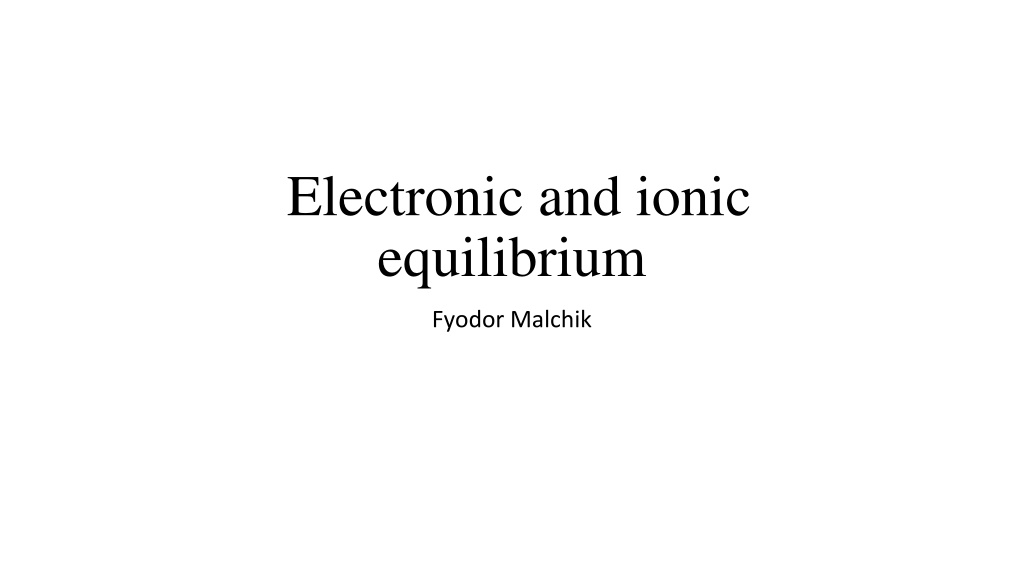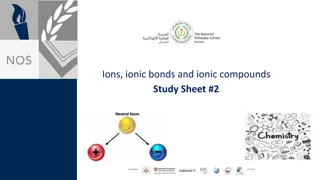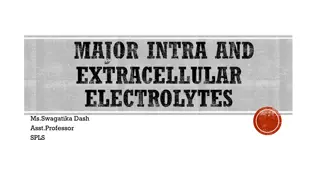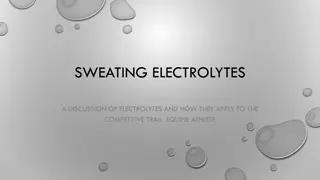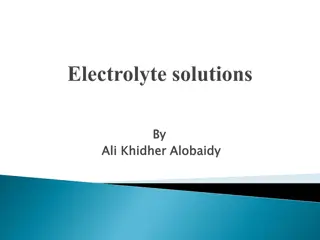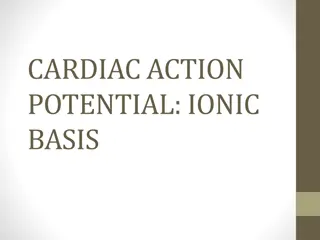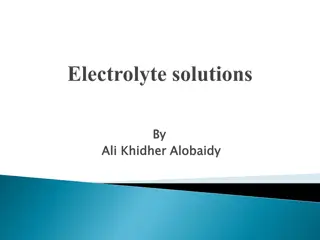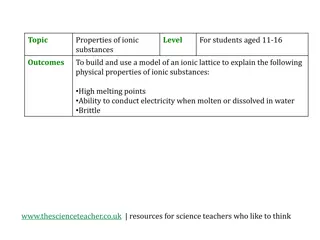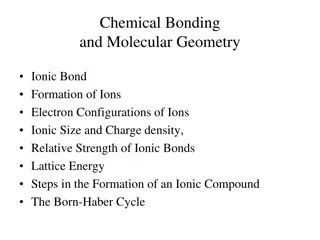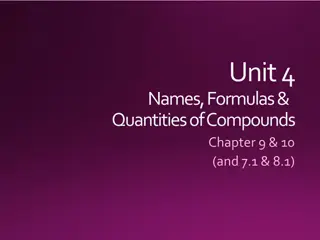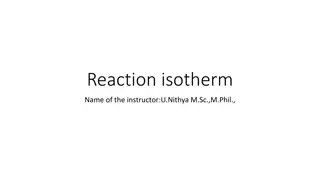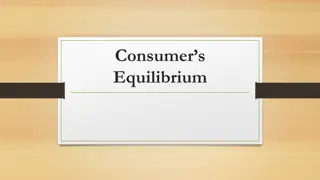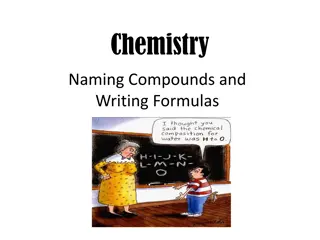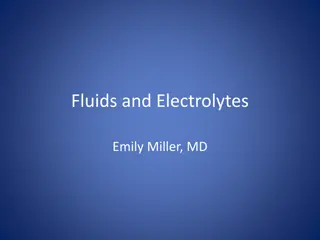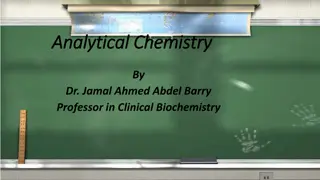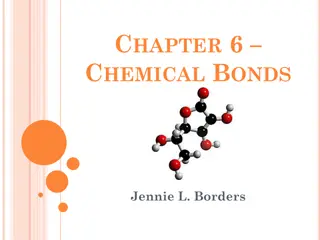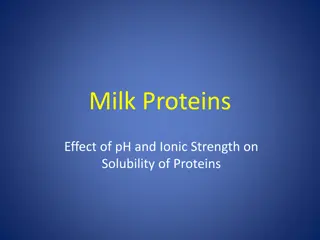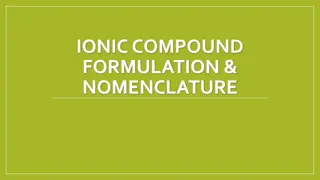Understanding Electrolytes and Ionic Equilibrium in Chemistry
Electrolytes play a crucial role in conducting electricity through ionization in aqueous solutions, with examples of strong and weak electrolytes explained. The concept of ionic equilibrium, degree of dissociation, and distinction between non-electrolytes are also covered in this comprehensive overview of electronic and ionic equilibrium in chemistry.
Download Presentation

Please find below an Image/Link to download the presentation.
The content on the website is provided AS IS for your information and personal use only. It may not be sold, licensed, or shared on other websites without obtaining consent from the author. Download presentation by click this link. If you encounter any issues during the download, it is possible that the publisher has removed the file from their server.
E N D
Presentation Transcript
Electronic and ionic equilibrium Fyodor Malchik
Electrolytes Substances aqueous solution due to ionization electrolytes. The responsible for the conduction and when the current passes through the wires, it shows the movement of free electrons through wire. This process of dissociation and flow of ions in aqueous solution of electrolyte is known as electrolysis. Example: Electrolysis of sodium chloride in its aqueous solution gives sodium and chloride ion in solution. which can conduct electricity are known as in solution is in their presence of ions 3
Examples of Strong Electrolytes Hydrochloric Acid NitricAcid Sulphuric Acid Hydro Bromic Acid Hydro IodicAcid Per ChloricAcid AceticAcid Carbonic Acid Ammonia Lithium Hydroxide Sodium Hydroxide Potassium Hydroxide Rubidium Hydroxide Cesium Hydroxide Calcium Hydroxide Strontium Hydroxide Barium Hydroxide (HCl) (HNO3) (H2SO4) (HBr) (HI) (HCIO4) (CH3COOH) (H2CO3) (NH3) (LiOH) (NaOH) (KOH) (RbOH) (CsOH) (Ca(OH)2) (Sr(OH)2) (Ba(OH)2)
Weak Electrolytes Electrolytes which are weakly ionized in their aqueous solution are called as weak electrolytes. In constituent ions are in equilibrium with un-dissociated molecules of electrolytes. the aqueous solution of weak electrolytes, the This type of equilibrium involving ions in aqueous solution is called ionic equilibrium. The dissociation of weak electrolyte is represented by Example: CH3COOH + H2O H3O++ CH3COO- 7
Weak Electrolytes Such type of equilibrium is called as ionic equilibrium. The fraction of molecules dissociates can be represented by using degree of dissociation. exists between ions and unionized molecule Generally weak acids and weak bases are good examples of weak electrolytes.
Degree of Dissociation() The degree of dissociation of an electrolyte is defined as a fraction of total number of moles of the electrolyte that dissociates into its ions when the equilibrium is attained. It is denoted byAlpha ( ) and given as: = Number of moles dissociated Total number of moles
Non-Electrolytes Non-electrolytes are the substances which cannot conduct electricity in their aqueous solution due to the absence of ions. They are generally polar compounds which can dissolve in water as molecules instead of ions. As covalent compounds contain covalent bonds bonded atoms, therefore cannot be ionized in their and exists in the form of molecule only. Example, Sugar (C12H22O11), alcohols are soluble in water but remain in molecular form only. C H O (s) 12 22 11 or non-polar covalent between solution C H O (aq) 12 22 11
List of Non-Electrolytes S.No Non-electrolyte Sucrose Glucose Ethanol Methanol Carbon tetrachloride Carbon disulphide Kerosene Chemically pure water Urea Dichloromethane Glycerol Methylsulfonylmethane (MSM) (CH3)2SO2 Carbon dioxide Oxygen Sulphur dioxide Chemical formula C12H22O11 C6H12O6 C3H3OH CH3OH CCl4 CS2 Hydrocarbons H2O NH2CONH2 CH2Cl2 CH2OH-CHOH-CH2OH 1 2 3 4 5 6 7 8 9 10 11 12 13 CO2 O2 SO2 14 15
Arrhenius Concept ofAcid and Bases In Arrhenius (1859-1927) proposed that acids and bases can be defined in terms of the chemical species they form when they dissolve in water. 1884 the Swedish chemist Svante August
Arrhenius Concept ofAcid and Bases Arrhenius Acid: According to Arrhenius substance which has hydrogen atom and can be given in the form of hydrogen ion in aqueous solution. Such substances are called as Arrhenius acids. For example, when acetic acid (CH3COOH) dissolves in water, it will form acetate ion (CH3COO-) and hydronium ion (H3O+). theory, acid is a
In the same way, HCl acts as Arrhenius acid in water and it converts to Cl- ion by transferring hydrogen ion to water. Arrhenius Concept ofAcid and Bases When Arrhenius acids are in pure state (not in solution) they are covalent compounds, that is, they do not contain H+ions. The ions are formed through an interaction between water and the acid when they are mixed. Ionization is the process in which individual positive and negative ions are produced from a molecular compound that is dissolved in solution.
Arrhenius Concept ofAcid and Bases STRENGTH OF ARRHENIUS ACIDS: On the basis of ionization of acid , they can be classified into two types: Strong acid: Those acids, which are completely ionized and give maximum number of proton (H+) in a solution are known as strong acid. The value of acid dissociation constant or strong acids (Ka) is very high. Hence, the strength of acid is directlyproportional totheacid dissociation constant (Ka). Example: HCl, HNO3, H2SO4etc. Weak acid: Those acids which are partially ionized i solution, like, acetic acid, hydrofluoric acid etc. are know as weak acids. The acid dissociation constant is less fo weak acids compared to strong acids. Example: CH3COOH, H2CO3, H3PO4etc.
S.No. Arrhenius Concept ofAcid and Bases Acid Chemical formula Ka 1 2 3 4 5 6 7 8 9 10 11 12 13 14 15 16 17 18 19 Per chlorate Hydrochloric Hydrophobic Hydrochloric Nitric Sulfuric Hydroponic ion Ionic Oxalic Sulfurous Hydrogen sulfate ion PHOSPHORIC Citric Nitrous Hydrofluoric Formic Cenozoic Acetic Water HClO4 HI HBr HCl HNO3 H2SO4 H3O+ HIO3 H2C2O4 H2SO3 HSO4 H3PO4 H3C6H5O7 HNO2 HF HCOOH C6H5COOH CH3COOH H2O Very large Very large Very large Very large Very large Very large 1.0 1.7 x 10-1 5.9 x 10-2 1.5 x 10-2 1.2 x 10-2 7.5 x 10-3 7.1 x 10-4 4.6 x 10-4 3.5 x 10-4 1.8 x 10-4 6.5 x 10-4 1.8 x 10-5 1.0 x 10-14
Arrhenius Concept ofAcid and Bases Arrhenius Base: An Arrhenius base is a hydroxide containing compound that produces hydroxide ions (OH- ions) in water. The basic species in Arrhenius theory is thus the hydroxide ion. For this reason Arrhenius bases are also called hydroxide bases. Example: NaOH(aq) Na++ OH-produces OH-in water. Some other examples of Arrhenius bases are KOH, Ca(OH)2, NH4OH etc. KOH(aq) K++ OH- NH4OH(aq) NH4+ OH + -
Arrhenius Concept ofAcid and Bases STRENGTH OF ARRHENIUS BASES Base Formula Ammonia Aniline C6H5NH2 Codeine C18H21O3N Diethylamine (C2H5)2NH Dimethylamine (CH2)NH Ethylamine C2H5NH2 Hydrazine Hyroxylamine Methylamine Morphine C17H19O3N Piperidine Pyridine Quinoline Triethanlamine C6H15O3N Triethylamine (C2H5)3N Trimethylamine Kb 4.75 9.37 6.05 4.51 3.23 3.36 5.77 9.04 3.38 6.13 2.88 8.70 9.20 6.24 3.28 4.20 NH3 N2H4 HONH2 CH3NH2 C5H5N C5H5N C9H7N (CH3)3N
Strong Electrolytes Strong Electrolytes: The electrolytes which ionise completely or near to completely are called strong electrolytes. General Examples: StrongAcids. Strong Bases Salts Examples: HCl, H2SO4, NaOH, KOH, NaCl, KBr,AgCl 4
Examples of Strong Electrolytes Strong electrolytes like salts are composed of oppositely charged ions. In solid state, these ions are held by strong electrostatic forces of attractions. When theses electrolytes are dissolved in water, the attraction forces between ions are highly weakened due to high dielectric constant of water.
LewisTheoryforAcid andBases Acid:A substance that can accept a pair of electrons to form a covalent bond. The species that can be Lewis acid are ? Cations such as H+, Fe2+,Al3+ ? molecules with incomplete octet central atom such as BF3, BeCl2 ? Molecules with central atom that can expand octet such as PCl3 ,SiF4, ? Molecules containing multiple bond such as CO2, SO2. Base:Asubstance that can donate a pair of electrons to form a covalent bond. The species that can be Lewis base are ? anions such as OH-, CN-, Cl- ? molecules with lone pairs electrons at the central atom such as H2O, NH3, ROH
LewisTheoryforAcid andBases Lewis Acid: A Lewis acid is an electron pair acceptor. The accepted electron pair is shared between the acid and the base in the covalent bond. Thus, Lewis definition of acidity includes many species in addition to H+. For example, various metal cations, such as Mg2+ and metal have compounds such as AlCl3 are Lewis acids because they vacant valence orbitals and can accept electron bases. pairs from Lewis
LewisTheoryforAcid andBases Type of LewisAcids: i. Molecules having a central atom with incomplete octet. E.g. ii. Simple cations. E.g. Ag+, Cu+, Fe3+. iii. Molecules having central atoms with empty d- orbitals. E.g. SiF4, PCl5. iv. Molecules containing a multiple bond between two atoms of different electro negativities. v. E.g. CO2,SO2. BF3, AlCl3, FeCl3.
LewisTheoryforAcid andBases Lewis Base: The substance that donates the electron pair. The donated electron pair is shared between the acid and the base in the covalent bond. In a more general sense, most oxygen and nitrogen containing organic compounds can act as Lewis bases because they have pairs of electrons. TYPESOFLEWISBASES Neutralmoleculeslike NH3,R-NH2,etc. Allnegativeionslike F-,Cl-,Br-,I-,OH-,etc.
